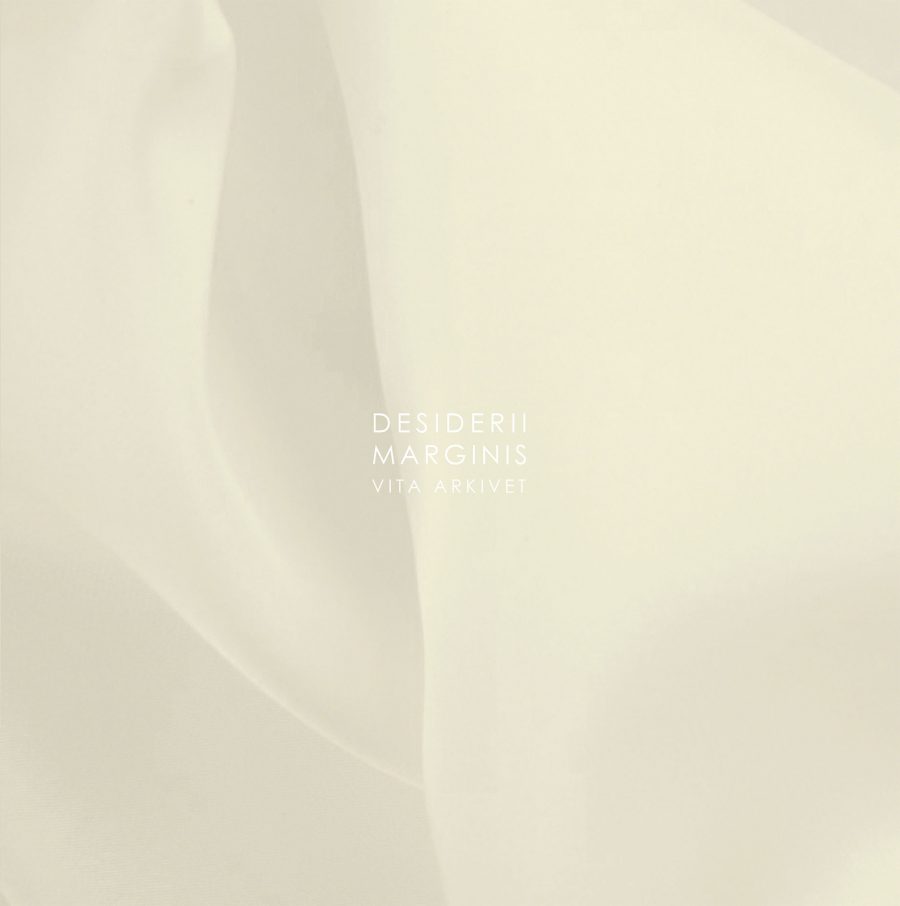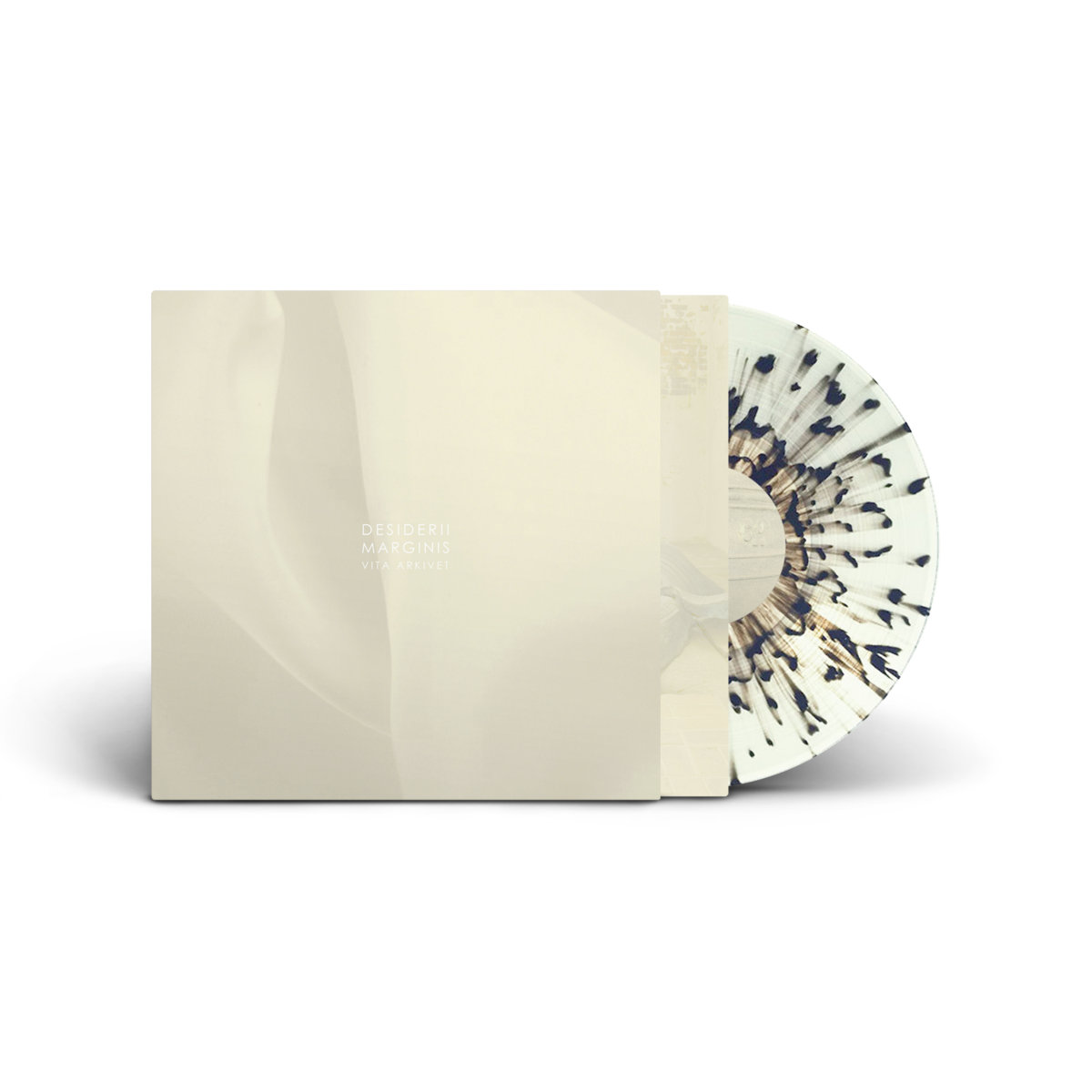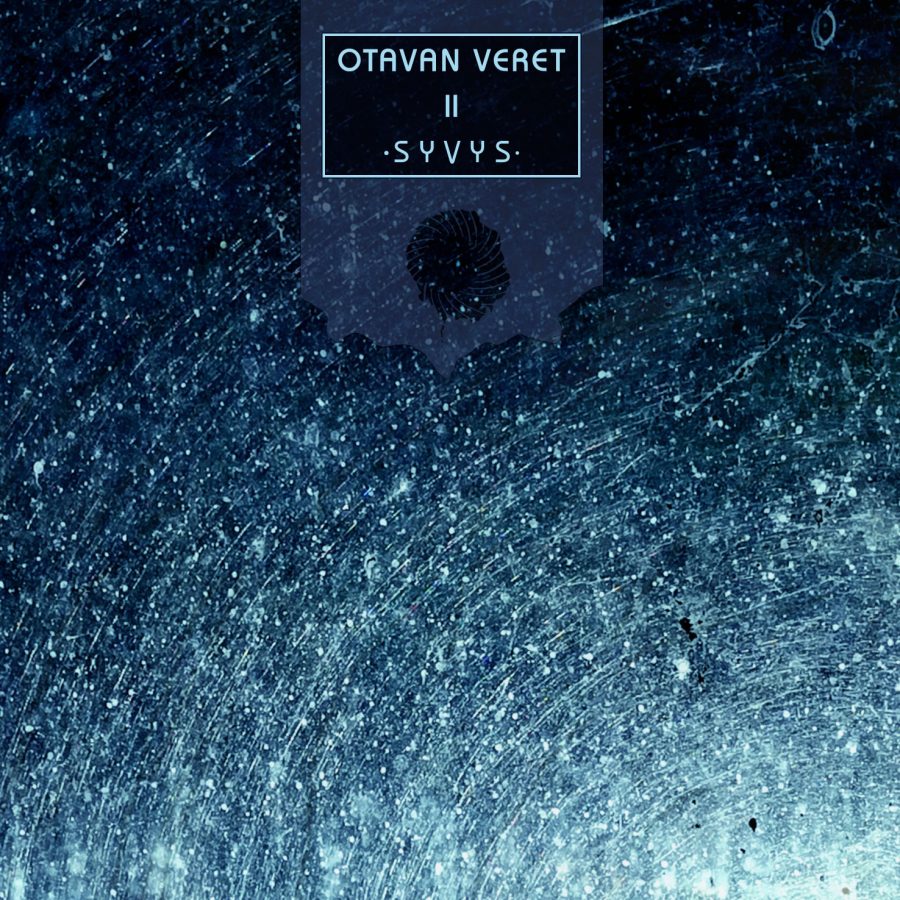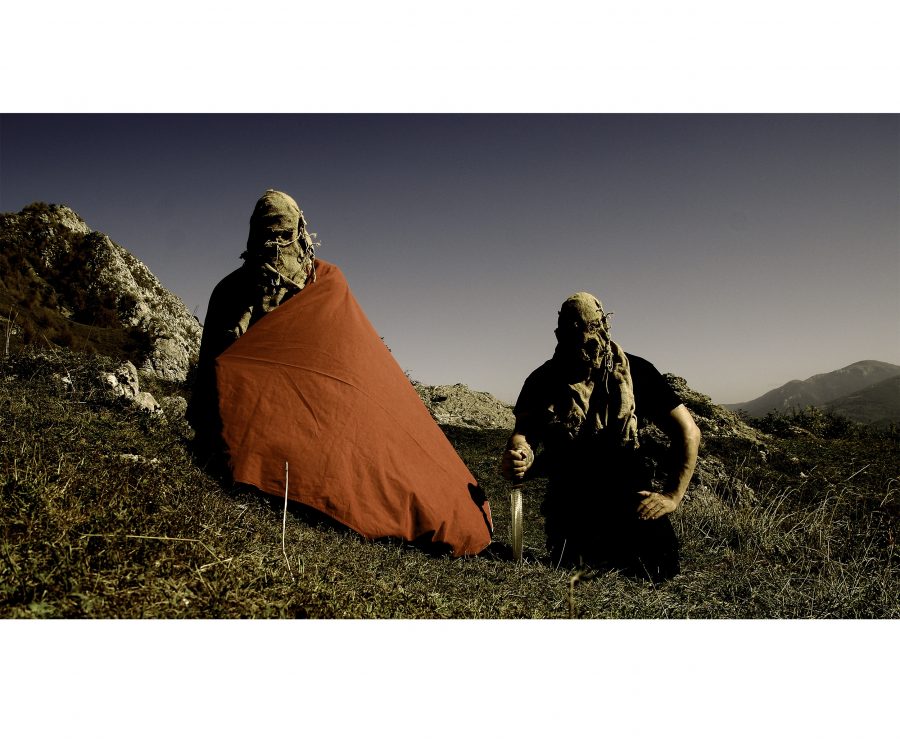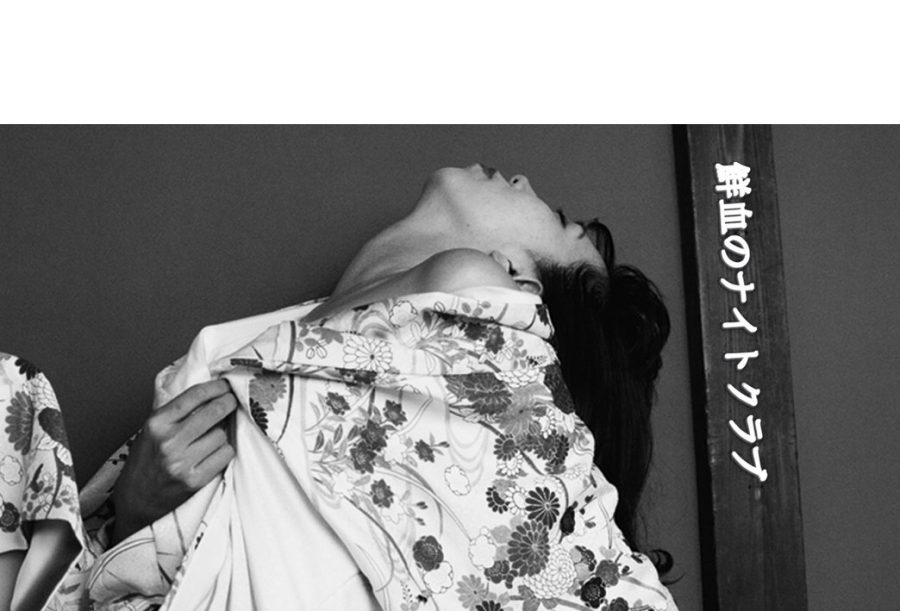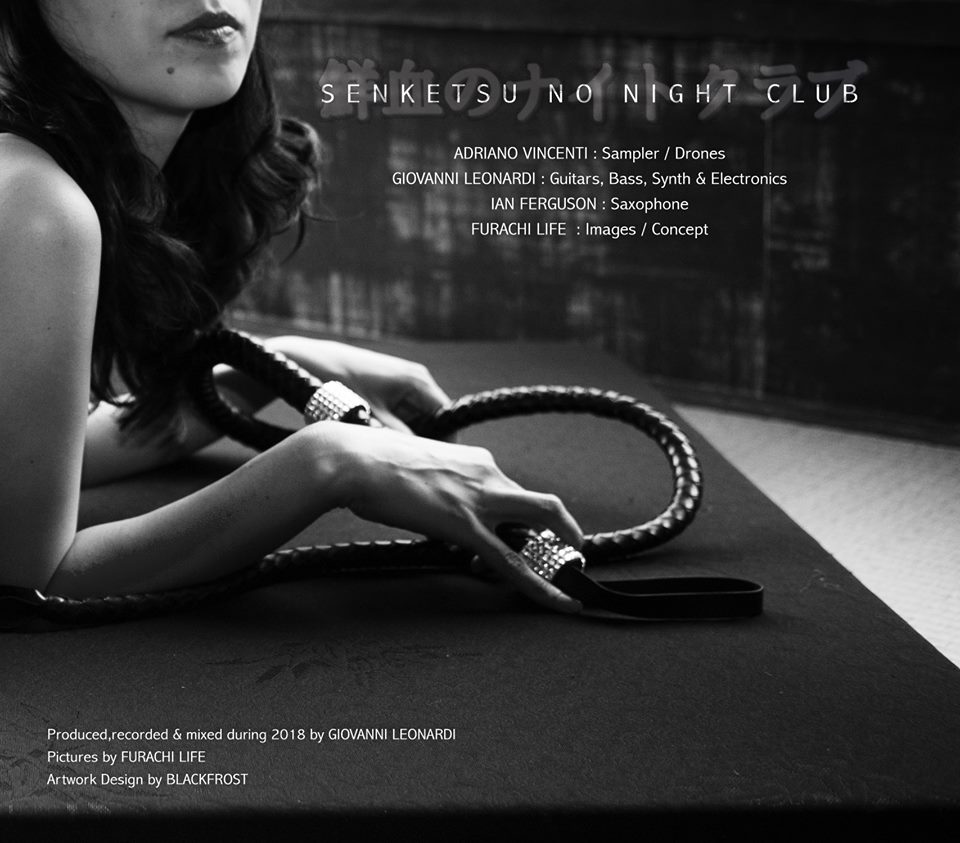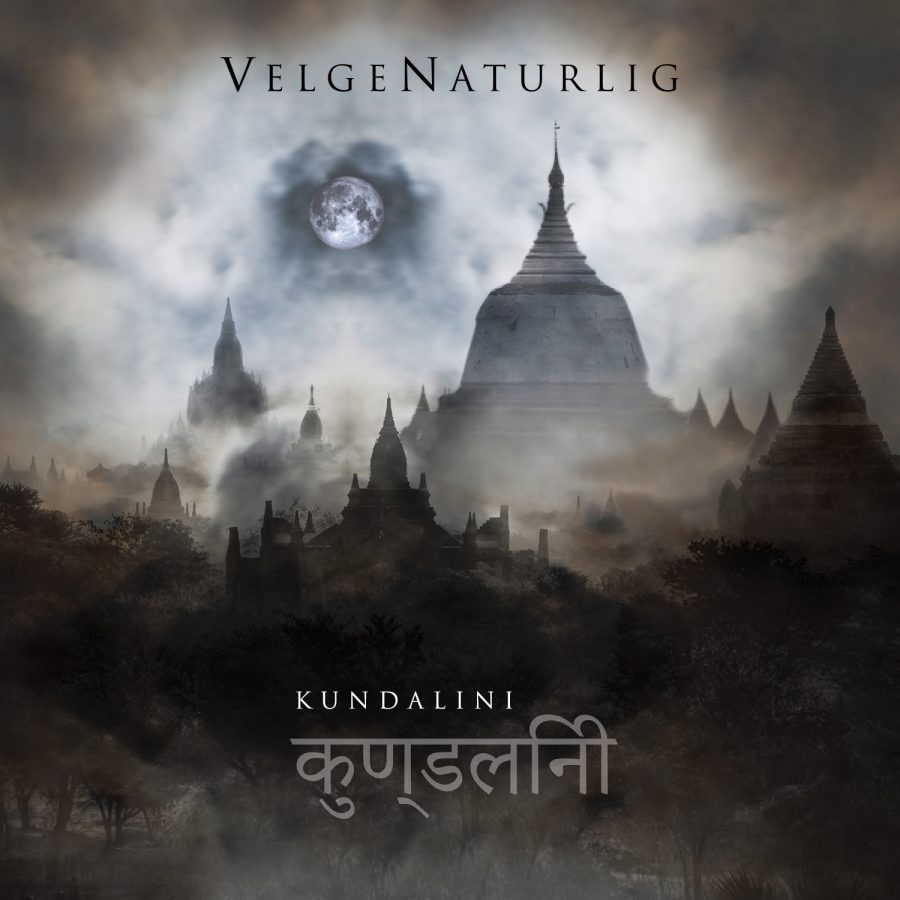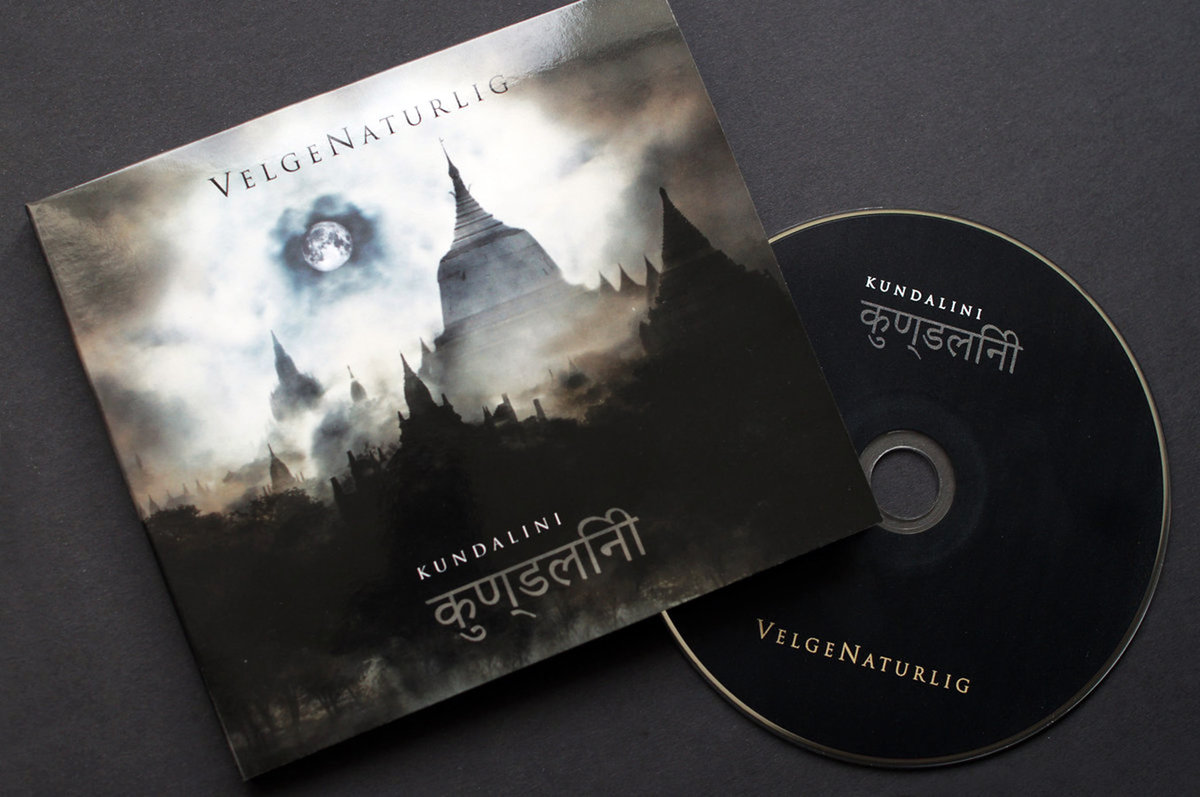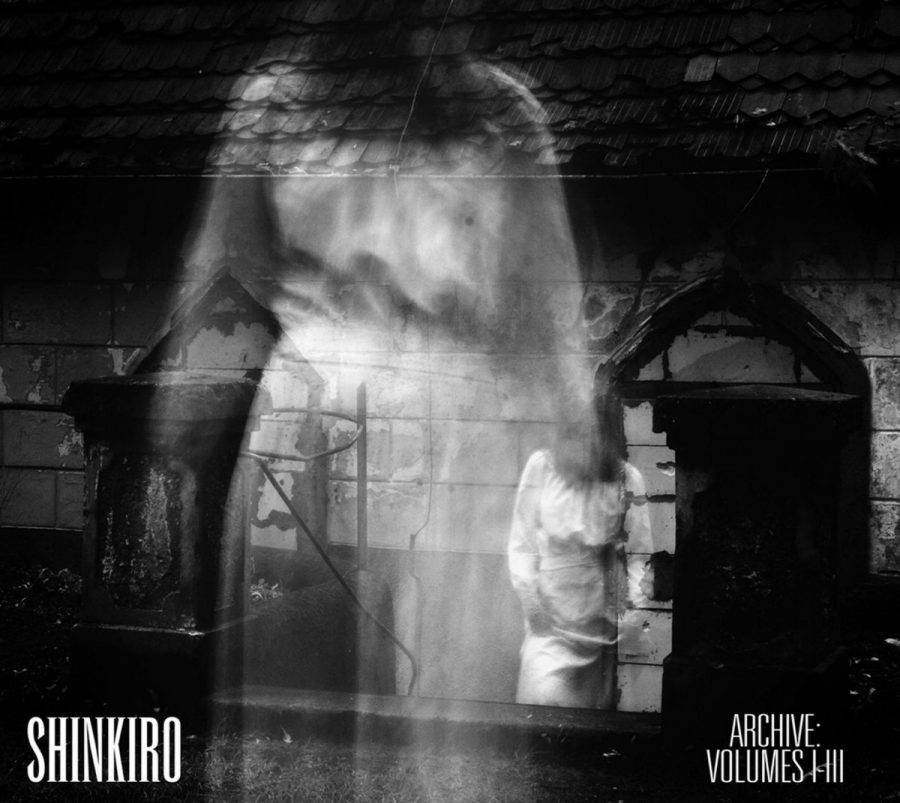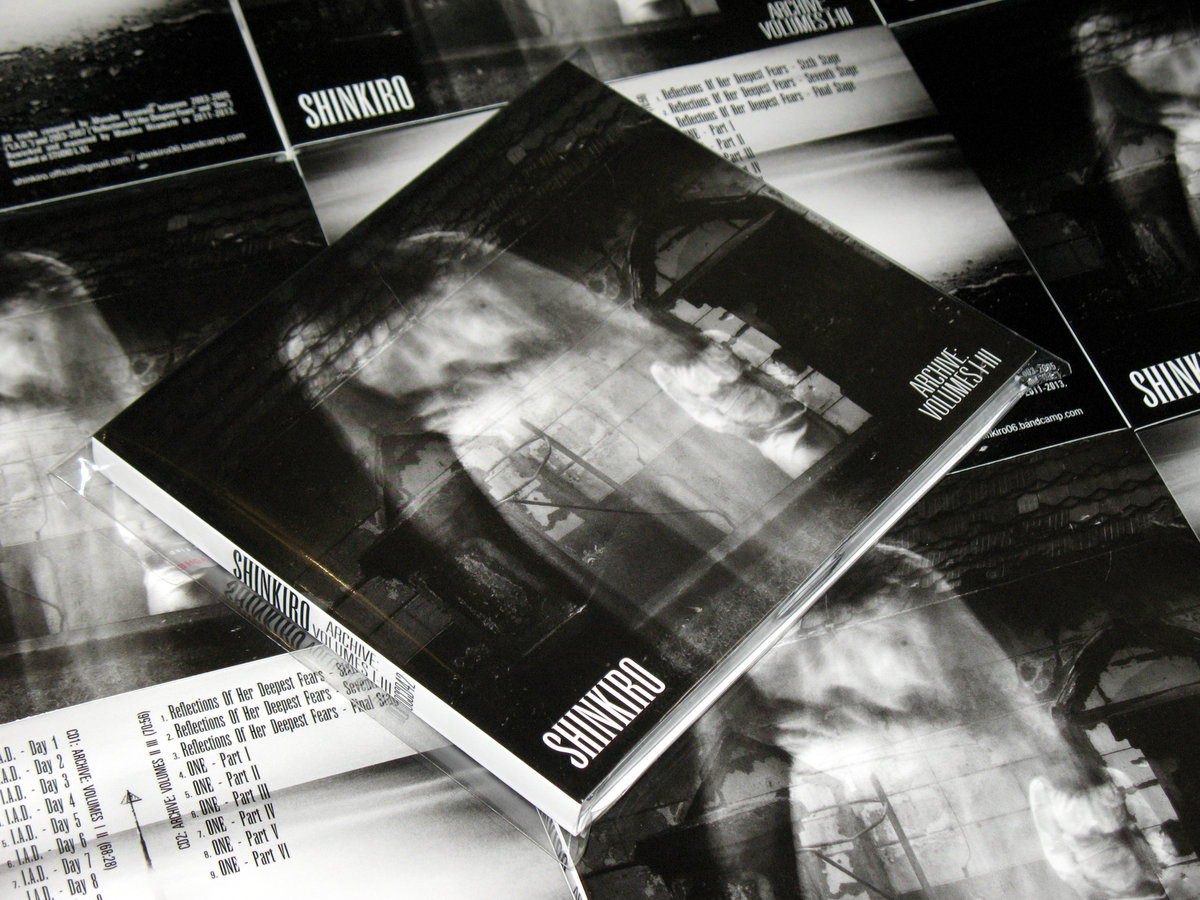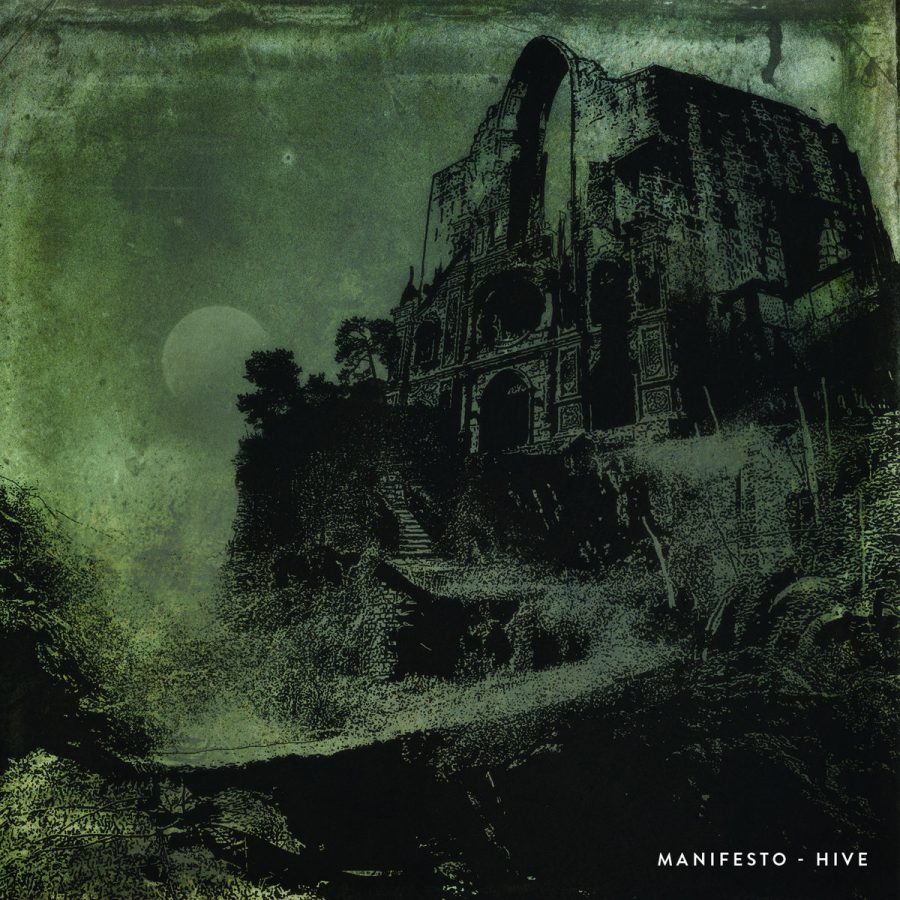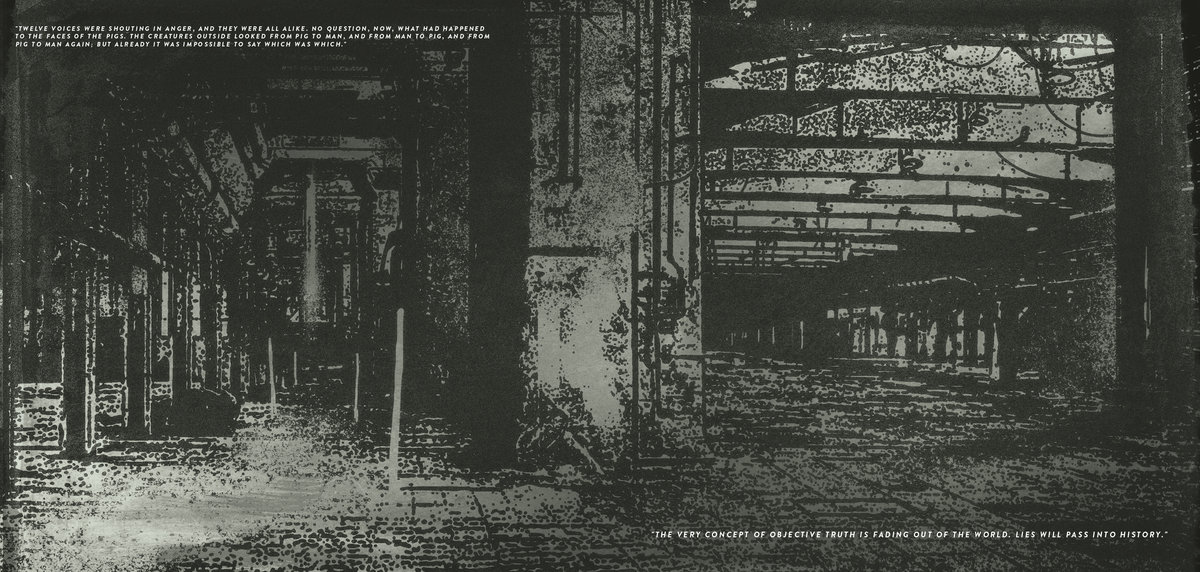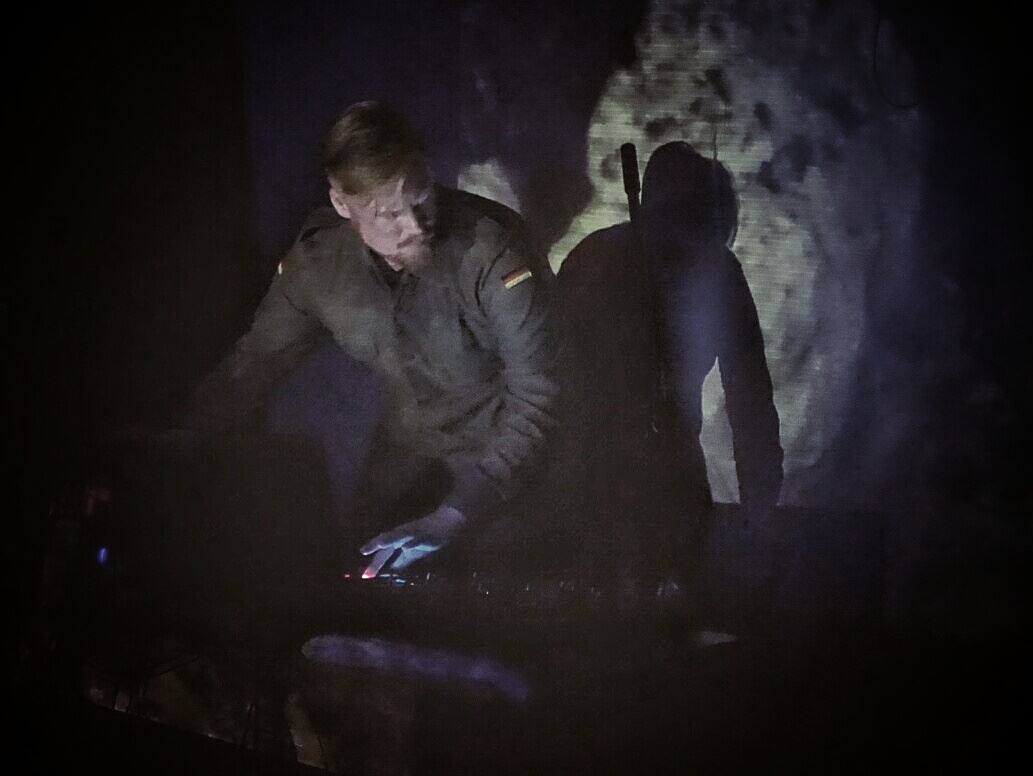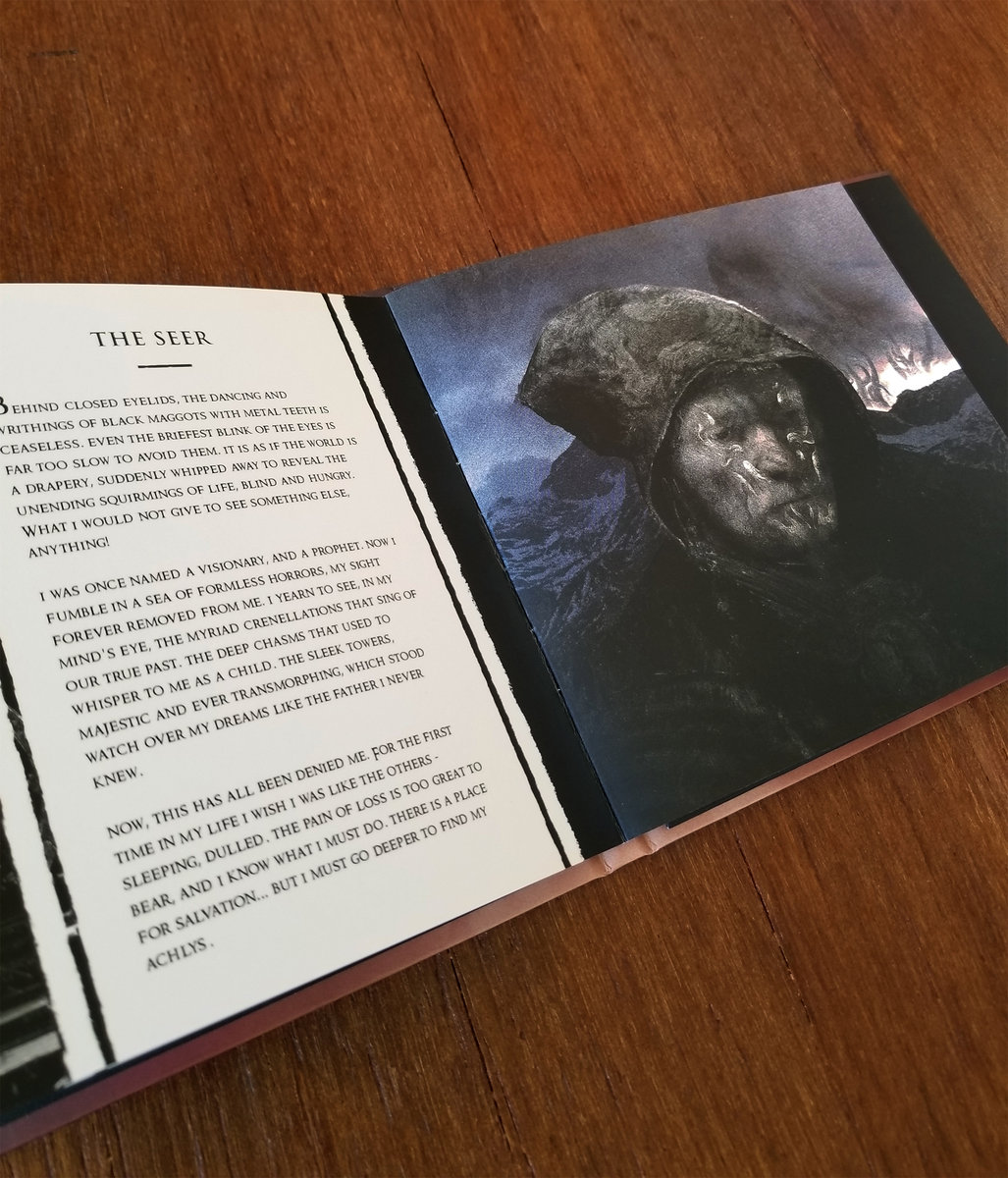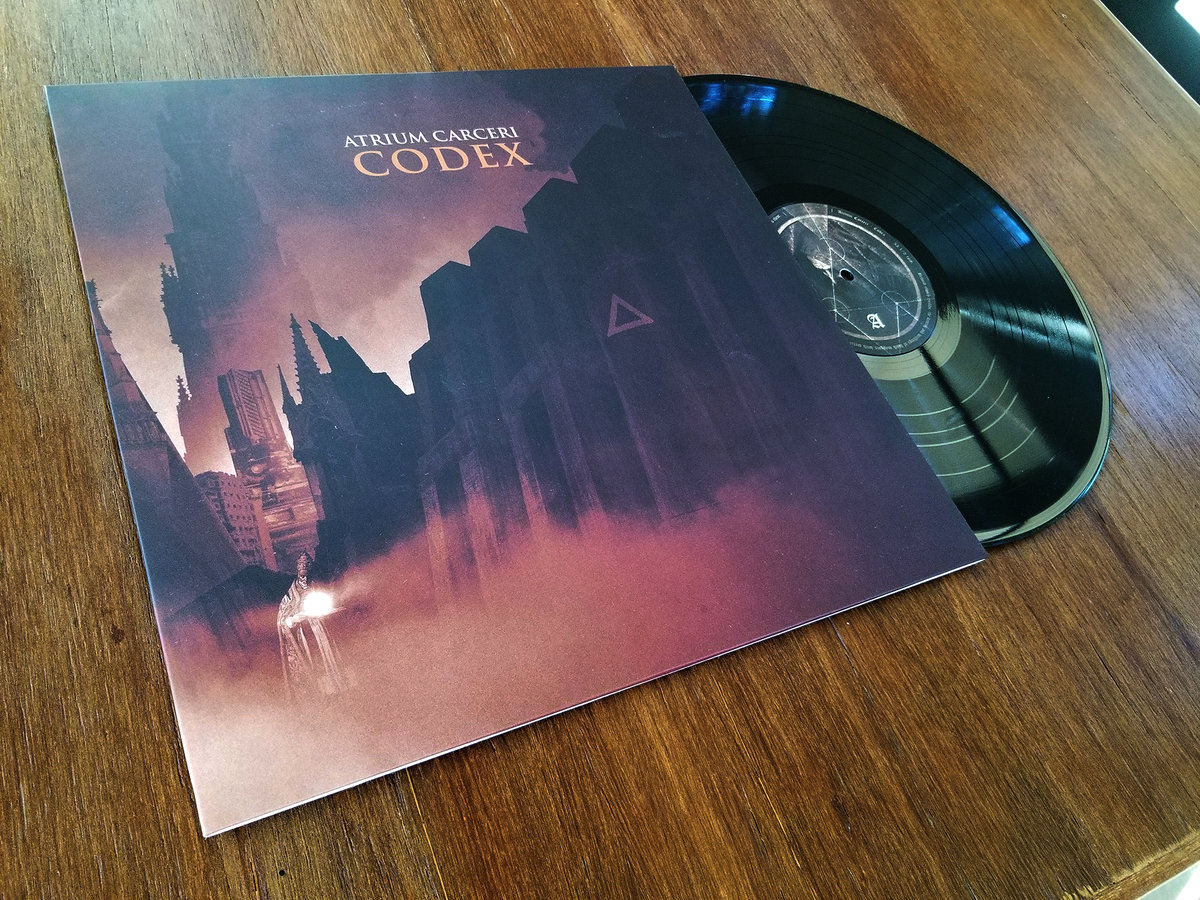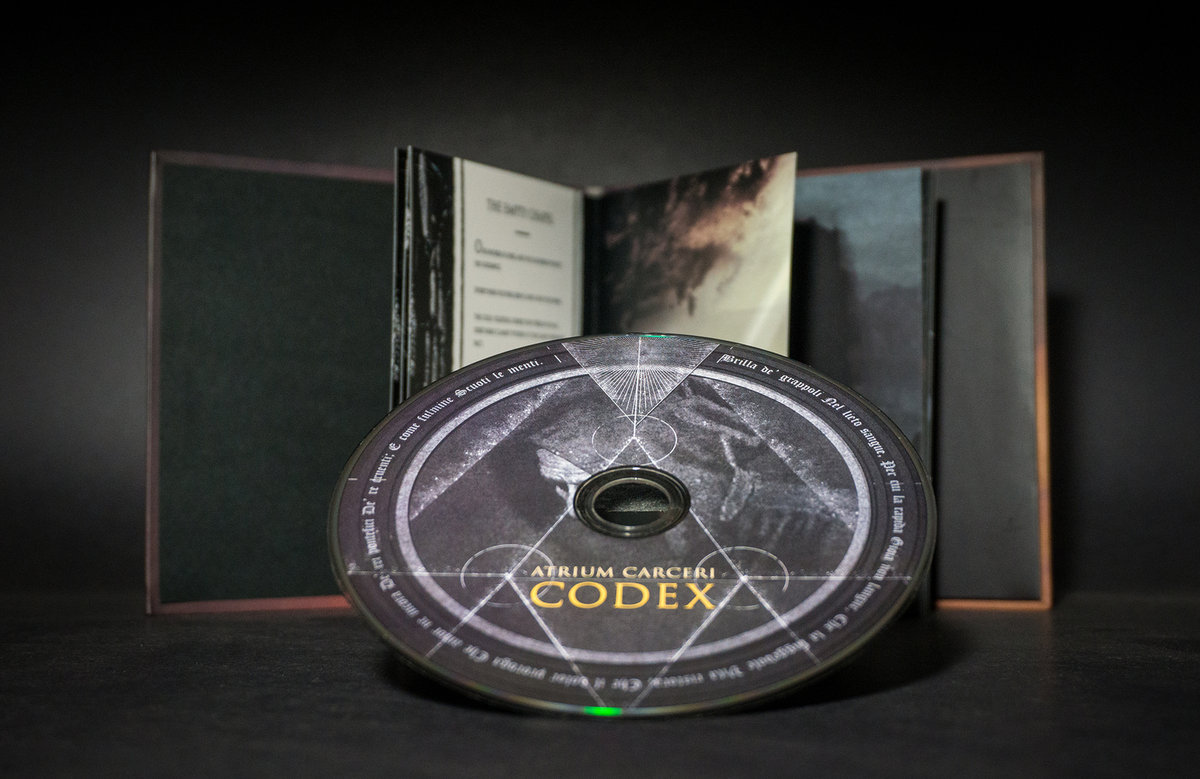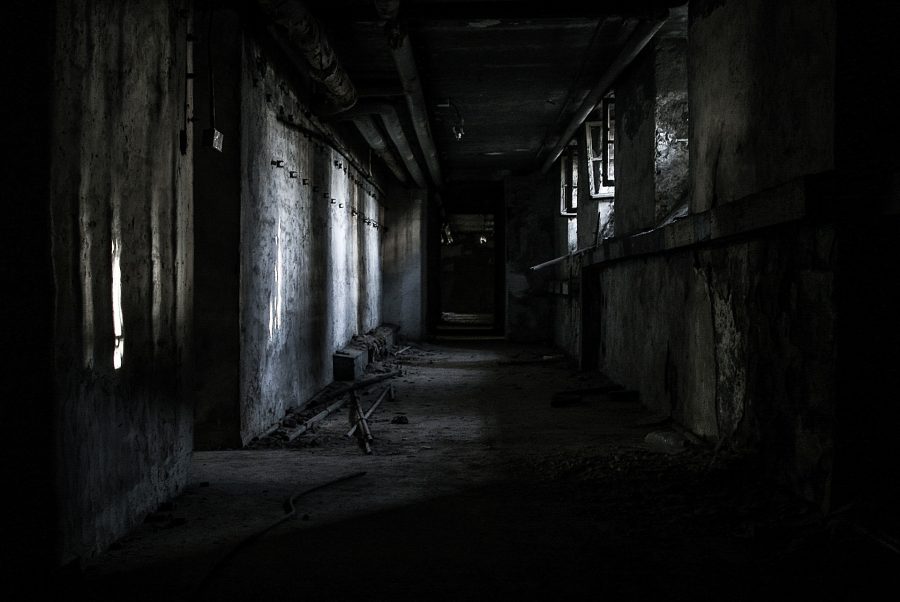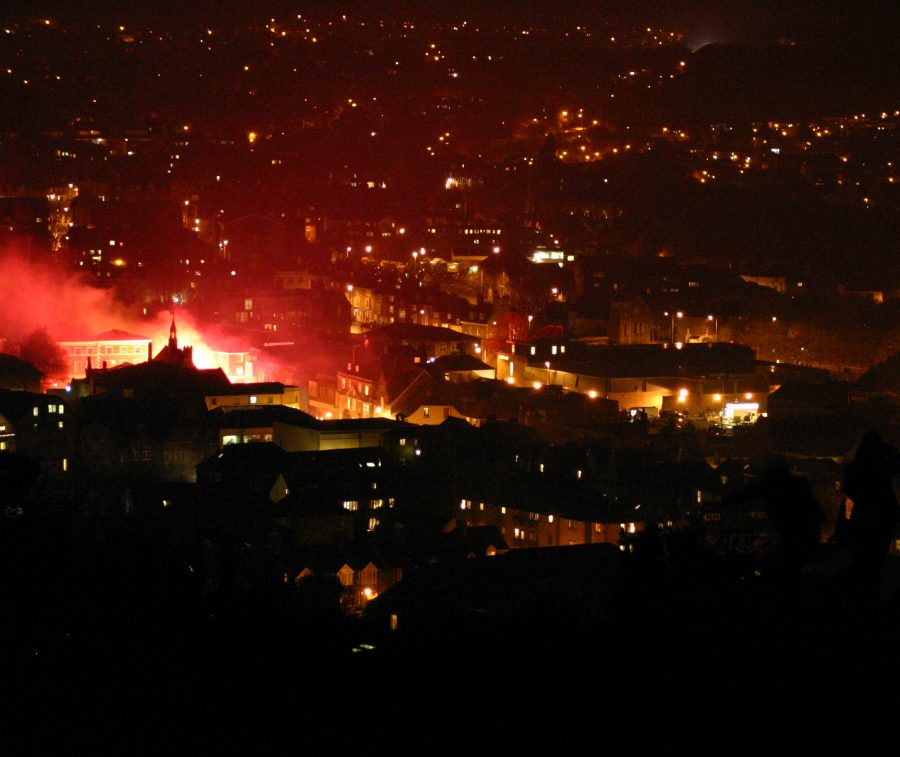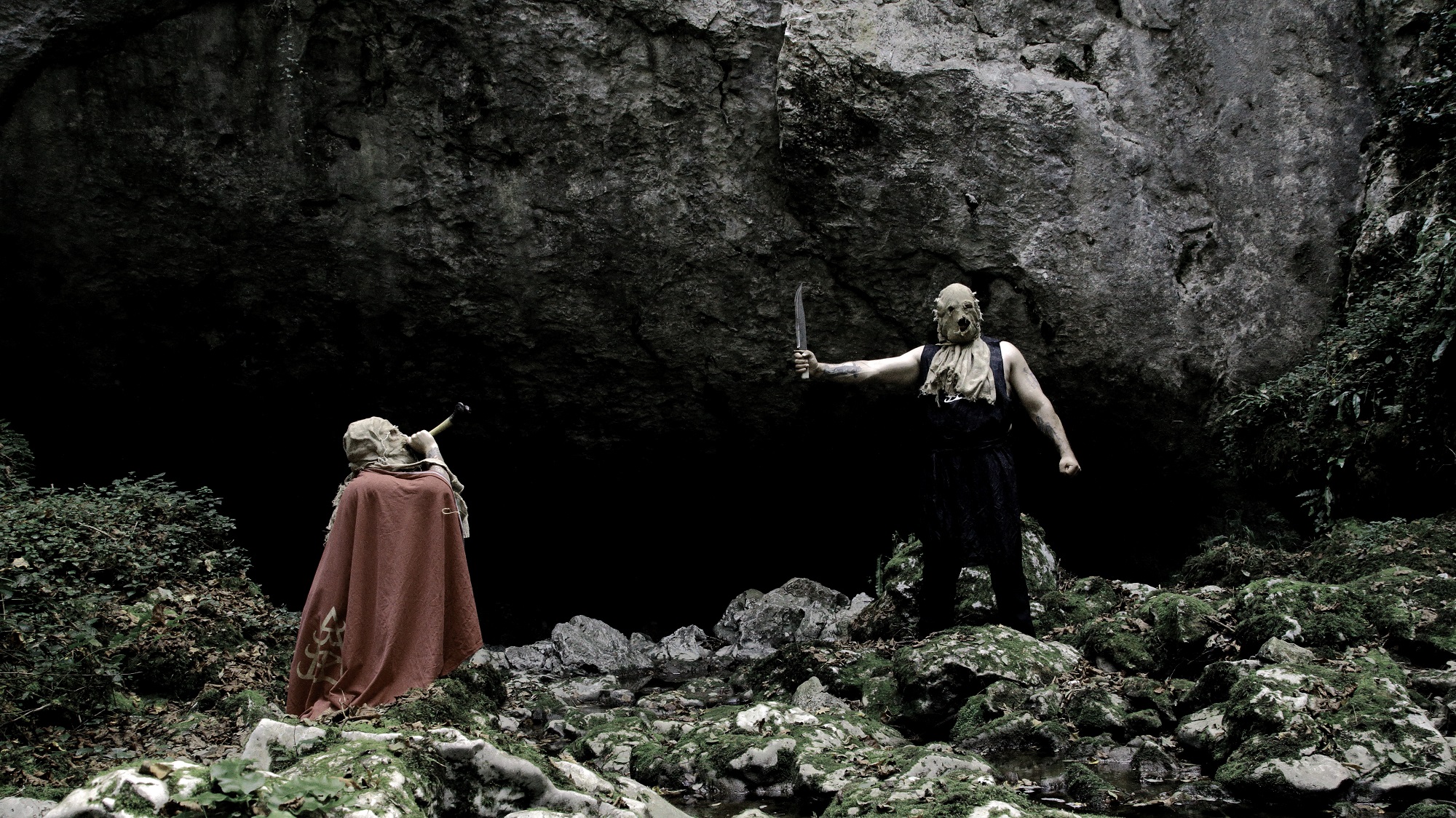
Credit: Arktau Eos
Arktau Eos are one of the most distinct and respected groups in the ritual post-industrial scene. They have been among the top-tier acts in many of the most revered festivals in the scene over more than a decade. Arktau Eos, like the Aural Hypnox / Helixes collective as a whole, exudes an air of authenticity and primal energy which is unrivaled by most, I would passionately argue.
There haven’t been a large number of interviews over the years with anyone from the Aural Hypnox / Helixes collective, though the ones available are certainly worth seeking out! So, it is with great respect and privilege that I am presenting you with this highly in-depth interview with Arktau Eos, who also have authority to, and do, speak on matters of the label at large herein.
In this interview we will be discussing the future of Arktau Eos, their greater relationship (or lack thereof) with music, politics and religion, their current views on physical, digital and video formats, analysis of Eremos and its context in the Arktau Eos discography, proper setting/atmosphere for deeper listening/understanding of their music, and quite a bit more!
Michael: Arktau Eos has been an essential group in the ritual ambient scene for more than a decade. Do you see yourselves on the same trajectory, following the same ideologies and aesthetics as when the group was first formed?
Arktau Eos: First, thank you for your kind words. We are certainly still on the same trajectory. Aesthetics evolve, ideas are fine-tuned, our technical know-how improves, but as for fundamental changes – there have been none.
Perceived changes usually relate to matters nearly wholly external. Being something of lone wolves and outlaws, we have, for instance, gradually drifted apart from categories such as ‘ritual ambient’ or ‘dark ambient’. Granted, those terms are not entirely without merit and many of our listeners fall into the demographic; no disrespect is intended. Yet we have searched for a slightly better fitting description, using ‘elemental music’ on occasion, in reference to its primal origins, suggesting a step aside from the dominion of chronology to seek the eternal, while simultaneously recalling the Paracelsian tria prima and similar formulations: everything has its base in a few active elements from which things of great complexity may nevertheless be composed by skilled hands, aided by knowledge of nature’s mysterious ways. Then again, we can agree with Alexey Tegin from Phurpa, who is adamant that Arktau Eos – like his own group – in fact has nothing to do with music per se.
Michael: Where do you see the future taking Arktau Eos? Should we expect another decade of releases?
Arktau Eos: Without any doubt. After all, Arktau Eos is a part of our respective life works, a point where our mutual interests and goals converge in a partially public context. We acknowledge Death as the grand initiator whose presence drives us to continue apace. This is not a statement of some inherent morbidity – we laugh too much to pass for the most ardent death-worshippers – yet it holds true in many senses, the basest one being that we realise the limits as to what can be accomplished in this lifetime at best. One can only hope it is enough to create a sustained awareness in areas of transition, including the final one that awaits us all. To this end, our records are travelogues and notebooks, quick sketches of eldritch spaces in mind or elsewhere (is there a difference?), cryptic but meant to communicate keys of access to others via suggestion and deep, universal symbols: beyond textual means, beyond sound even.
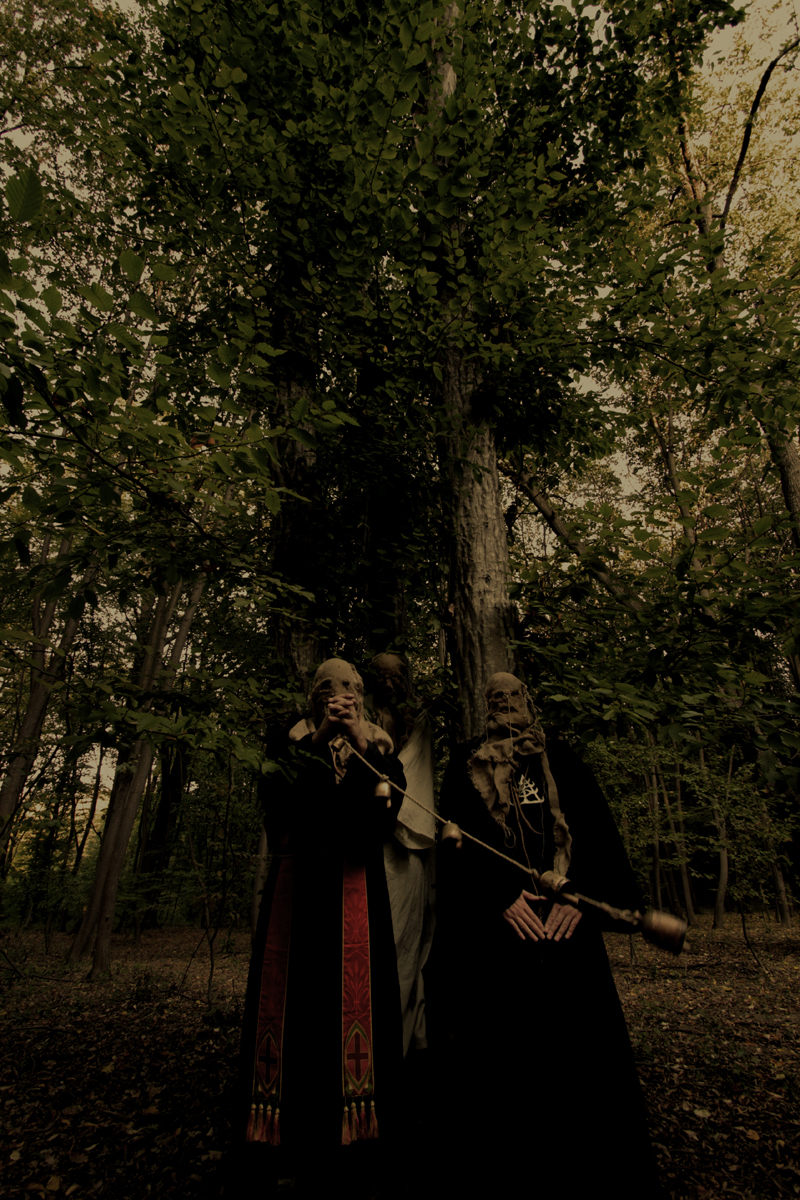
Credits: Costin Chioreanu
Michael: What is the current line-up of Arktau Eos? Is this still a fluid roster, keeping the core members A.I.H. & A.I.L., but interchanging other members from album to album?
Arktau Eos: It has never been a fluid roster really. We have returned to the original Arktau Eos pact, a duo formation, and intend to keep it that way. If we require the expertise of additional musicians or artists, they will be invited as guests of honour and lavished with fine wines, champagne and Cuban cigars, but typical ‘band’ dynamics are usually just a hindrance to the actual work at hand, and to be avoided.
Michael: Your last release Catacomb Resonator as well as its predecessor Unworeldes were released on vinyl. Your newest album Erēmos has returned to a CD-only format. Does each release dictate its own physical characteristics (cassette/CD/vinyl), or do outside influences (market/pricing) dictate the choice?
Arktau Eos: A combination of both. CDs will in all probability remain the label mainstay. Rather sadly, vinyl is becoming increasingly infeasible for us. So much is good about vinyl, but the odd frequencies and lengthy tracks present lots of problems mastering-wise and reliable pressing plants are few. Catacomb Resonator is a case in point. While it turned out decent and benefits from the vinyl sound, the process of getting there was taxing to the point of ridiculousness – the endless travails of its emergence included inspecting and sending back every single copy of the entire run! Cassettes are less finicky. Genuine tape saturation and hiss usually work wonders for our sonics anyway.
As a side-note of potential interest to some readers, it remains a distinct possibility that we pushed our luck too much with Catacomb Resonator. Its third song or side (‘The Third Canticle’ of the liner notes), the real core of the record, is merely implied by hidden motifs on both sides A and B, residing soundlessly in-between them as a sort of ‘charged absence’… perhaps this artificial tension overloaded the aura of the album, playing a part in its troubled manifestation. This matter cannot be explained in plainer words, so we’ll leave it at that.
To get back to the original subject slightly: contrary to expectations the recent vinyl boom did not benefit any of the Aural Hypnox artists even marginally, so frankly, a release must justify its appearance on vinyl exceptionally well for the format to be even considered. Such are the realities as we speak, however disappointing to the vinylophiles among us.
Some Aural Hypnox customers have remarked that a CD is an easy (!) way to bring along Arktau Eos for walks in the woods and mountains. In fact, portability is the only sensible reason for download codes we have ever come up with; perhaps we will relent and add them to the physical releases sometime in the future as a gesture of good will towards those few folks inclined to take our music to accompany their private pilgrimages.
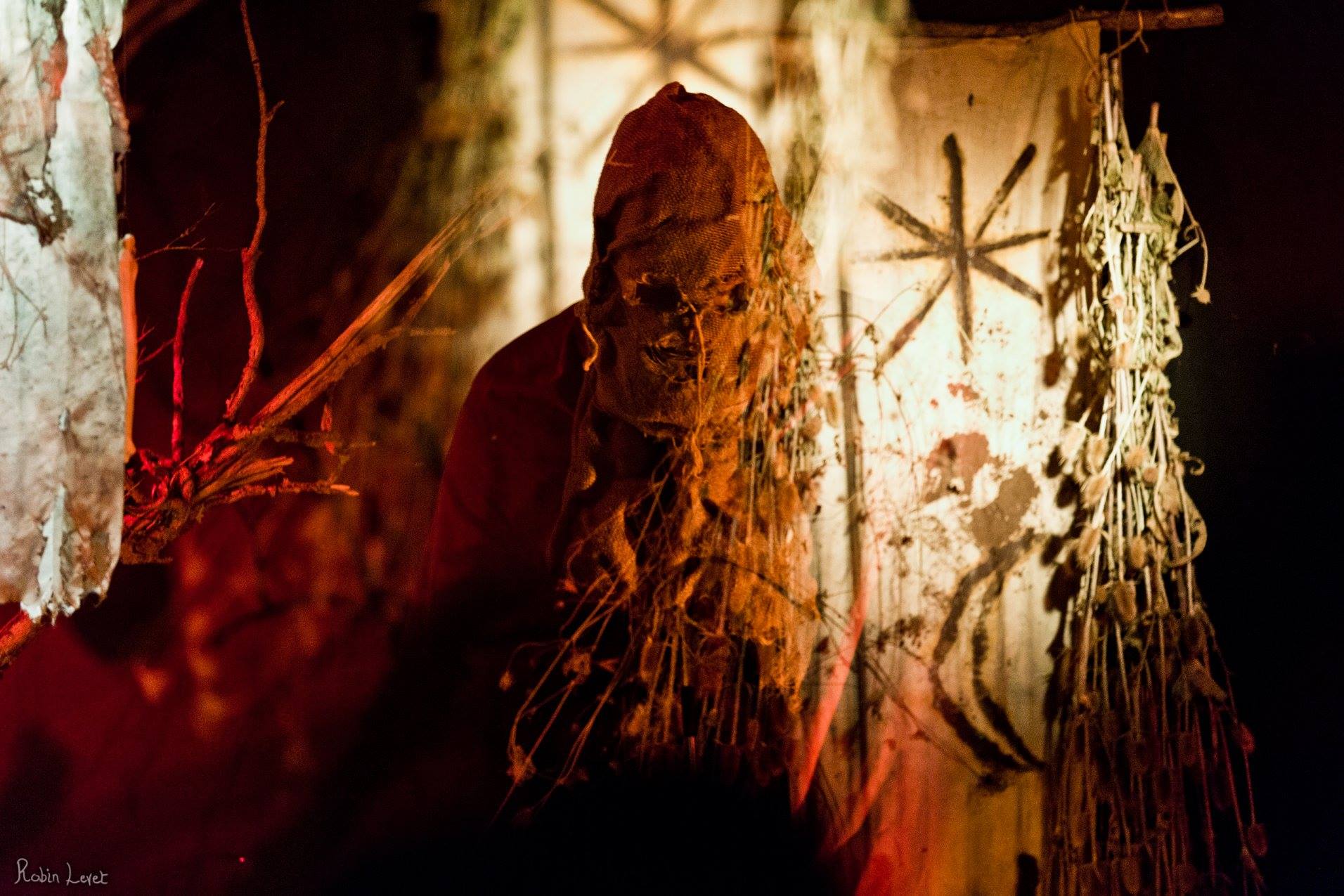
Credit: Robin Levet
Michael: You’ve worked again with the artist K.T.L. on the artwork for Erēmos. Is K.T.L. a part of the Aural Hypnox/Helixes collective, creating music under one of these projects? Or, is this someone from the outside world you’ve sought for collaborations?
Arktau Eos: Our collaboration came about the most natural and hassle-free way possible. Timo Ketola, or K.T.L. as he is known in the Hypnox circle, is A.I.L.’s friend since the ‘90s and has been more or less clued in to Arktau Eos’ ways of working ever since the release of Mirrorion. Having vast experience of metaphysical and artistical subjects consonant with ours, K.T.L. adapts easily to our peculiar whims and is a rich source of ideas himself. He is mainly known as a visual artist, a highly talented draughtsman and painter, who in recent years has also been apprenticing in the art of tattooing. However, A.I.L. and K.T.L. did perform together as boreal electro-Behenian duo Astrolithos in Salerno and Rome back in 2017; K.T.L. did percussion. The Astrolithos set was demoed to an advanced stage, but there hasn’t been a suitable opportunity to finish it.
Most pertinent is that we will be working with him again for the 2019 Blow Up festival in Helsinki; with a bit of luck, this also means another new release from Arktau Eos. In a way, we continue in the spirit of the Origin of Fire event in Stockholm in late 2017. At Origin of Fire, Welt, Ketola, and S.A. Hynninen exhibited their work, while Arktau Eos, Stephen O’Malley, Aluk Todolo and Corps provided the evening’s sonic backbone. A 96-page exhibition catalogue was released that night including a foreword by Bobby Beausoleil. It is well worth getting if still available.
Michael: Erēmos contains field recordings from the North Ostrobothnian Woods in Northern Finland, as well as the “untamed steppes of Mongolia”. Was the idea for Erēmos conceived unexpectedly during your travels to Mongolia in 2014? Or, did you travel to Mongolia with the creation of this album in mind?
Arktau Eos: No, the concept of Erēmos is not tied to these travels originally. It was conceived in late 2017, when we were finishing Catacomb Resonator, its distant relative. The recordings were drawn from our archives because they fit and enhanced the concept. It was not premeditated at all. We have unused recordings all the way from our early days, and often they just reappear when needed. A.I.L. also did additional recordings in solitude at a remote Tantric Buddhist initiation temple in Mongolia – with permission, we might add: the gifts of the spirits are unexpected and numerous! Those recordings are yet to be used. They need a context, something more ritualistic than Erēmos could convey, whereas the rationale for using the field recordings on Erēmos is tied to the polarities these remote places – the Finnish woods and the Mongolian steppe – represent. While both are potential locations of retreat, they are in many ways opposites. The eternally blue skies and the openness of the steppe is contrasted with the dank, dark, forbidding nature of the Finnish woods, the open air ovoos with the minuscule cell of a solitary monk etc. The vision that unfolds when listening to Erēmos is an unspecified ‘desert’, that is, a mind-scape of extreme retreat which manifests according to the individual, not necessarily something that has a physical presence or counterpart. Fittingly, after an absence of a few years, solar-Apollonian elements have also crept in, most notable in this sense is “Pacts of Stone and the Sun”, recorded during the Summer Solstice.

Credit: Jeanne Saint-Julien
Michael: Also on the topic of release formats, will there be plans for more full-length video releases in the future, similar to Taiwaskivi and R.A.S.H.N.K.A-RA by Halo Manash? Or, do you now prefer just doing individual music videos, similar to the recent Templum N.R. “The Unseen Tailor”?
Arktau Eos: Individual videos seem to be the way forward. The bigger issue here is not the format or length but the actual content: for instance, R.A.S.H.N.K.A-RA was fine for its time, but the focus of Aural Hypnox video productions has since shifted. Instead of depicting ritual customs, our interest right now is in their after-effects, in painting impressions of what it means to do a ritual and what sensations it evokes – and for ‘ritual’, please take a broad view and read also meditation, summoning, prayer, etc. The problem with ritualistic videos is that they are very much tied to a certain moment. Watching them after the energies have departed might satisfy someone’s curiosity for procedural minutiae, but that is neither here nor there. The power and intent are already elsewhere.
Michael: It’s been stated in past interviews that Aural Hypnox seeks to remain separate from any specific religious doctrines. Is this also the case specifically within Arktau Eos? If there are any universal beliefs followed within Arktau Eos, what would they be?
Arktau Eos: Perhaps it would be more accurate to say that while we do not avoid any specific religious doctrines, we tend to steer away from their most common or vulgar expressions. Alternatively, you could say there is an Arktau Eos filter at work. While recognizing the immensity – perhaps impossibility! – of the task, Arktau Eos attempts to reach beyond the obvious appearances to deeper ur-currents that feed the present religious, magical, or mystical expressions, remaining untainted by political agendas or intellectual fads. One must learn the mystery of the mask and the masked to do so without impunity, with open heart and discerning intellect. In our home studios, we are constantly surrounded by markers of this enigma; wooden idols, thangkas, icons, nkisis, and so forth, which may or may not leave their imprint to what we do – but at the very least their presence draws our minds back to the work whenever they start to drift toward everyday worries, which have no place in our studio-laboratory environment. While we shun shifting beliefs or paradigmatic approach to religion as a folly of the rootless, we refrain from proclaiming a single doctrine of truth; we leave preaching to others, and in general tend towards detachment and the apophatic. Power itself does not gain from being drawn towards the human; it is richer without limitations, some of which are instantaneously in effect, should we desire to address it.
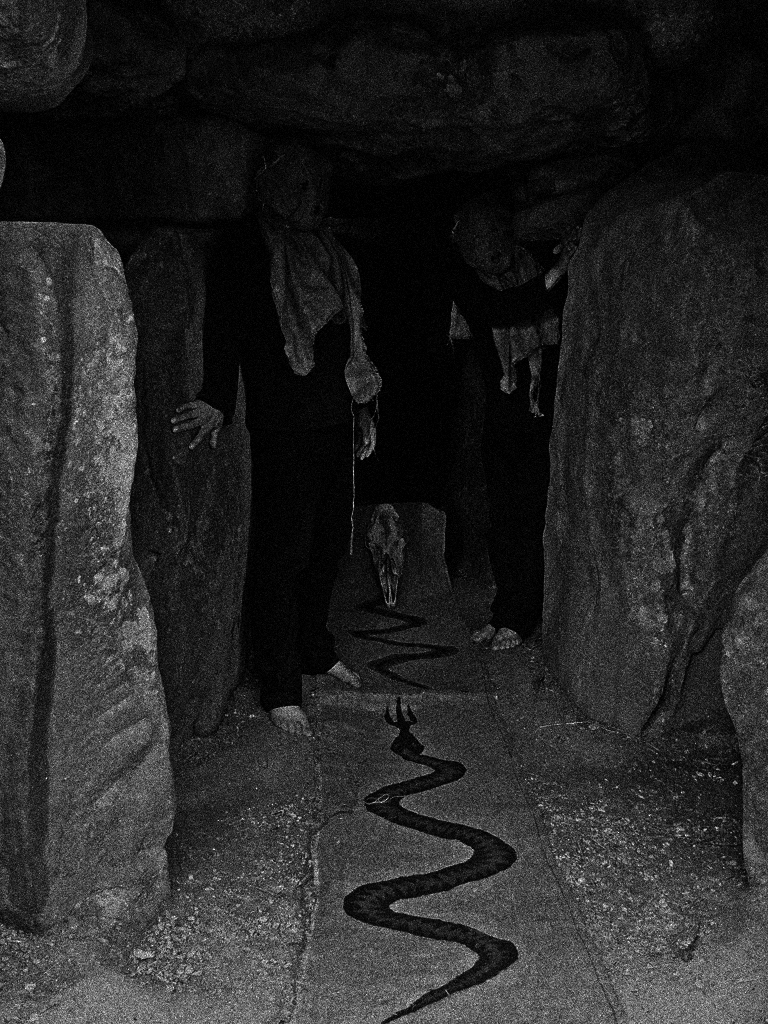
Credit: Gavin Semple
In a practical sense, to remain on the same page regarding Arktau Eos, we assume a few working hypotheses which pertain more to cosmological and ontological rather than religious aspects. A few delineations follow, which may be of interest to the few who care about such matters. Most of these general ideas are nothing new: visualizing the vertical dimension as comprising of three distinct realms, understood as the underworld, our world, and the celestial and stellar domain. Man’s unique role may well be joining the superior with the inferior as Hermetic-derived traditions insist, yet sometimes it feels like we are lightning conductors and not logical operators in doing so! The universe appears to express harmony and correspondence, and analogical thinking enables us to correlate its contents and consolidate some of the seemingly conflicting world-views and maps of reality, while the axiom of the inner being the outer and the within being the without is a Gordian knot best split by the blade of sudden insight, not intellect. There is life before birth and life after death; even biologically speaking we return to the elements through the work of worms or the agency of fire. Some dreams appear to arrive from beyond these dramatic realignments, and they may even eradicate the boundaries shaping that which we in the wake world identify as ourselves (Ioh-Maera is heavily concerned with this process). Arktau Eos as an entity appears to stand motionless at the edge of twilight, Janus-faced, yet it walks the route of the return and the widdershins way at the same time, continuously realizing their unity as a point afresh in the eternity of NOW.
Michael: Arktau Eos, like Aural Hypnox as a whole, focuses on the mystical and spiritually connecting to the natural world. Do any members hold strong political views/beliefs which dictate the direction of the project? Put differently, do you see the current global issues, particularly focusing on the environment, as an important element in your artistic output? Or, do you try to stay focused on your own lives and remain separated from any greater political/cultural dialogues?
Arktau Eos: We make some conscious choices in our daily lives to reduce our impact on the environment, but we are not activists or especially politically orientated. To those who argue that no act at all is without political undertones, we may appear conservative: after all, we value the survival of old beliefs and traditional handicrafts. On the other hand, our sonic output obeys no rules at all. Arktau Eos sessions are devoid of political discussions. While we leave politics, and environmental politics in particular, to those more eloquent and passionate about them, for what it’s worth, it should be clear to anyone who has ever held an Aural Hypnox artefact in their hands that we want to create things that are of lasting value, forsaking throwaway produce and culture, and view purely utilitarian preying on the environment as short-sighted and negative.
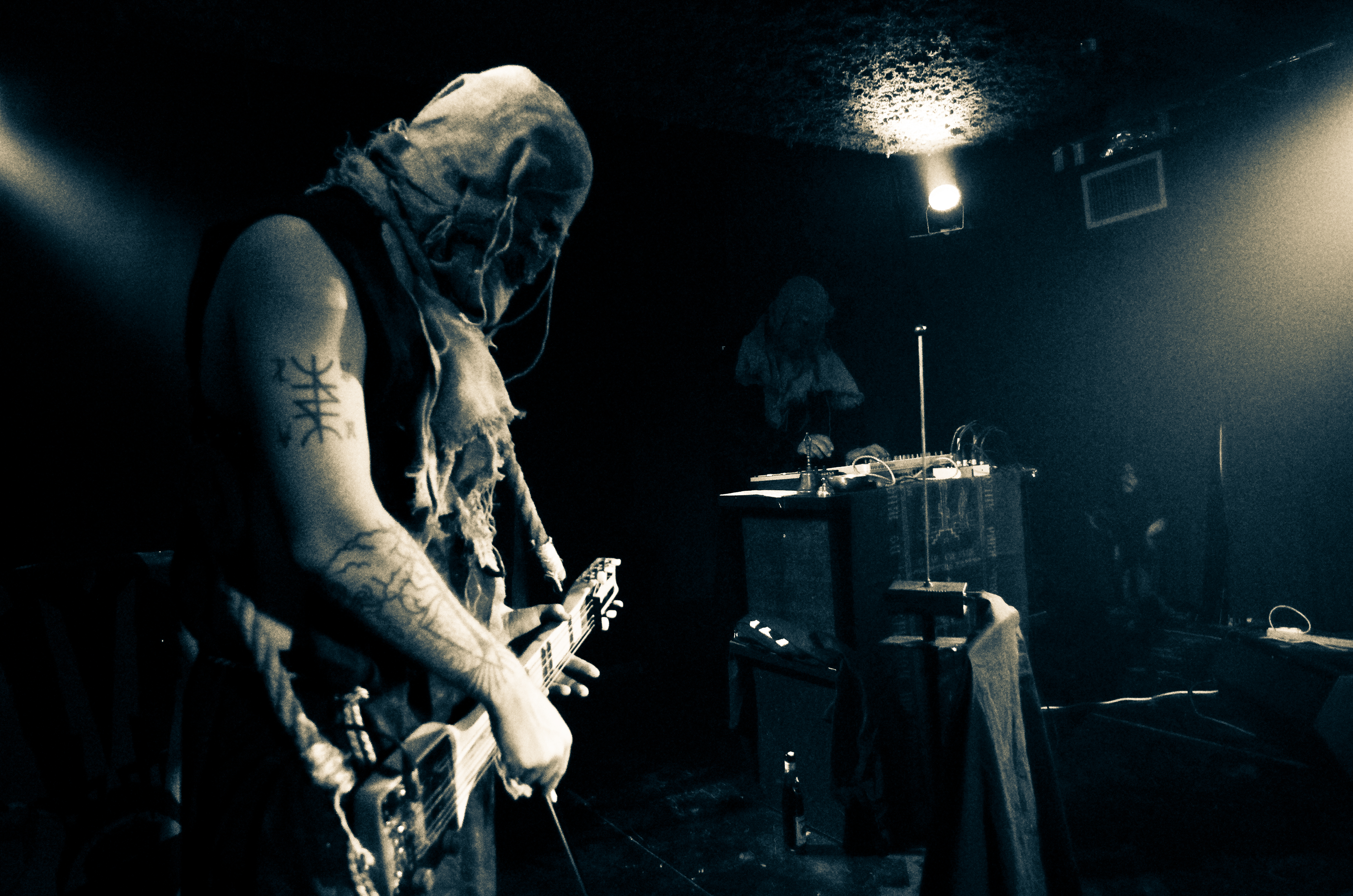
Credit: recviem-art.ro
Michael: If you do see a need for concern, do you consider the output of Arktau Eos to be a way of reconnecting humanity to the natural world?
Our interest in this direction lies in the interactions of man with specific places in the natural world, the portals and power-zones, sites of attested theophanies and curious photic phenomena, unusual geomagnetic and geographical regions, mountaintops, caves, holy springs and lakes, nemetons, etc., all of which inspired our ancestors to marvel, worship gods known and forgotten, build shrines and tumuli, and erect megaliths based on stellar and solar alignments. Churches upon Mithraeums, chapels upon spots of pre-Christian apparitions… the layers are many and all are fascinating.
The otherworld is never but a figurative step away, but these liminal locations appear to amplify the catacomb resonances, the sense of the otherness, at times causing the veils of separation to unravel forcefully. Perhaps they are there to compartmentalize our experience, for who can withstand the full incursion of the greater reality unprepared? Beyond those veils certain sites shine as beacons to which flock entities that may bear little or no resemblance whatsoever to human life. Whether the impromptu sabbatic revels ensuing from encounters with such non- or un-beings still count as engagements with the natural world is obviously a matter of debate!
There are more things in heaven and earth, Horatio,
Than are dreamt of in your philosophy.
– Hamlet (1.5.167-8), Hamlet to Horatio
Our age lacks the framework for comprehending such experiences and casually relegates them to the category of the supernatural, now used pejoratively, stigmatizing unusual phenomena by equating them with hallucinations or glitches of brain-functions. All in vain hope that this would somehow nullify the nagging unease brought on by them displaying characteristics we are accustomed to associate with ourselves and related species, such as intelligence and independent will. We are not opposed to hard sciences and we value critical thinking, but merely wish to point out, as Shakespeare had Hamlet state to Horatio, that “there are more things in heaven and earth … than are dreamt of in your philosophy”. We have sent probes to Mars, which is all great, and even the depths of seas are becoming familiar to scientists, although their hold on imagination has not let go. And probably never will, so primal is the strata in which the idea of the abyss, tehom, resides, welling up as the waters of Genesis or earlier creation myths like that of the Bṛhadāraṇyaka Upaniṣad. Yet, even today much on this planet remains little known, just consider the vastness of deep biosphere and how it defies expectations with its strange lifeforms: microbes living hundreds of thousands of years, for instance. Try, then, to explain the complexity of our imaginative faculty or of consciousness: the shoreless ocean or, indeed, abyss, the evolution of which spans geological epochs!
Some of our innate sensitivity to the numinous itself – the capability for apprehending pure awe that carries no moral or ethical baggage – has been lost, perhaps irrevocably. The common man has his senses dulled, his mind distracted by the ‘whys’ and ‘wherefores’, as if there would ever be an end to the chain of questioning. The culprits contributing to this sad state of affairs are numerous, but we could start with urbanization, light pollution, unnatural pace of life, over-reliance on technology, and the forceful shifts in our way of thinking since the Industrial Revolution, not to mention imperious scientism rife among the myopic and petty types. Religions and supposed experts on spiritual matters are not without fault themselves, having often accrued ways of conceiving the divine in terms unduly influenced by social and sociopolitical patterning. It is a precarious balance, to be sure.
In our own small way, we attempt to reverse the damage, cultivate an understanding of sacred sites within Arktau Eos, and walk their precincts with reverence. This is a reconnection, but alas! of a kind that will never be popular. Perhaps one must have a Gnostic sense of unease to seek out the forbidden and hidden to begin with. Few are truly called.
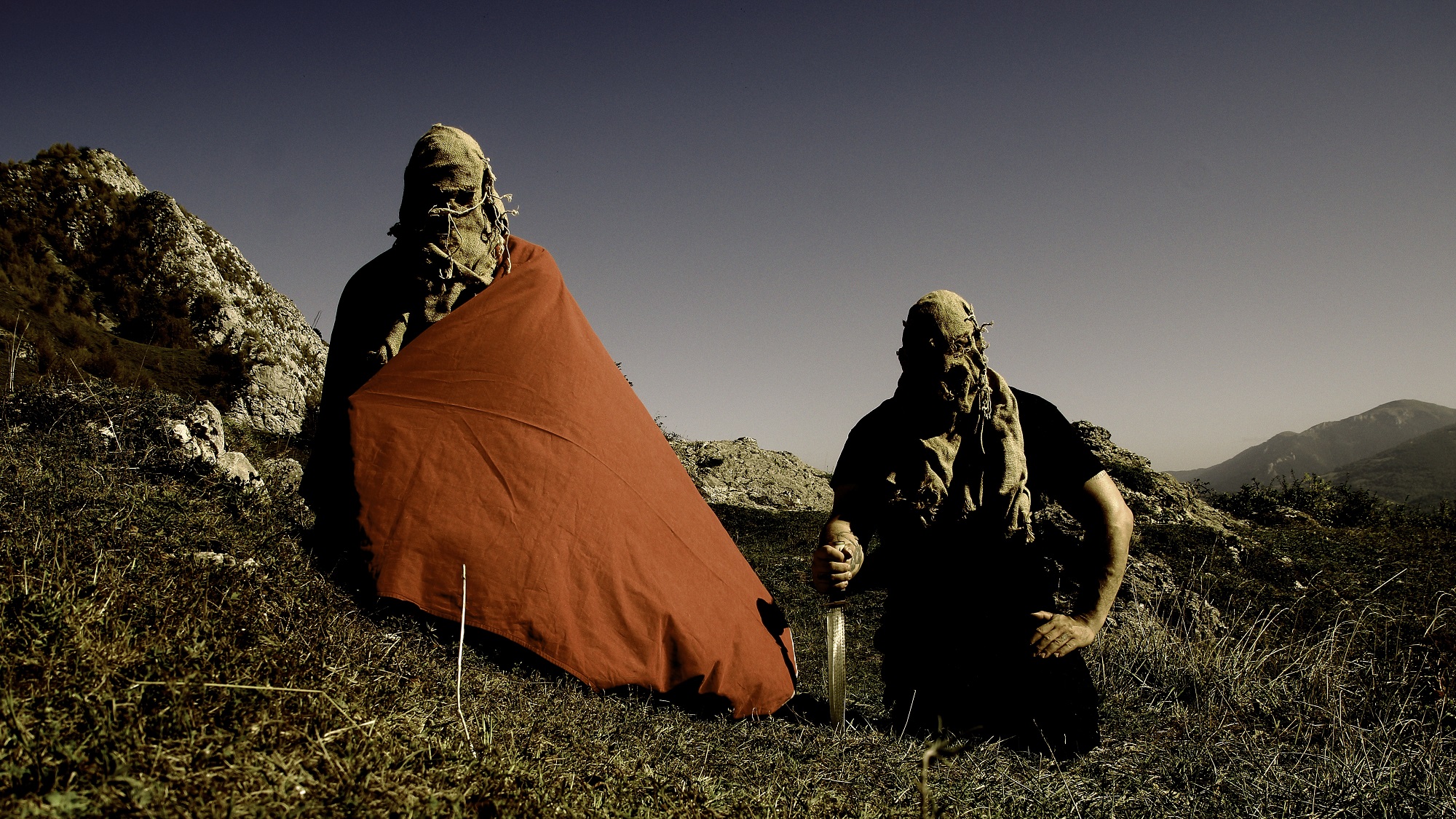
Credit: Arktau Eos
Michael: Aural Hypnox has previously unveiled Mount Hypnox, a line of hand-crafted incenses which could be used in connection with the label’s releases to further connect the listener to the aura of the music. Would you have any recommendations for the best incense blend to better connect the listener to the new album, Erēmos?
Arktau Eos: Erēmos calls for something uncomplicated. Locally available tree resins and the scent of a campfire are enough. Further down the line, we will probably release an Arktau Eos incense blend of more complexity. It should be clarified here that while we often use incense live, it is to add an extra dimension to the proceedings, an appeal to the olfactory senses to deepen immersion, and not to appease someone’s desire (fixation) for ritual as such. Immersion is vastly more important live than ceremony. The live shows should be more akin to a prolonged dream than a routine ‘ritual’ – at least they work better viewed that way.
Michael: Do you have any recommendations to listeners on the best way to enjoy this new release? Should it be enjoyed casually? During meditation? During one’s own rituals? Is there a right answer?
Arktau Eos: The gist of it is, indeed, that there is no correct answer. Over the years we have heard back from many listeners and have been pleasantly surprised about the ways people have deeply engaged with our albums. The knowledge that our records have been used in the rituals of certain magical orders and Neognostic enclaves is also gratifying in that it speaks volumes of their applicability and capability to communicate in such highly charged settings. Nevertheless, Erēmos is so unambiguously focused that a suggestion is hereby offered: it just might be best suited to lonely wanderings and meditations, whatever form they take. Trust your instincts. And by the way, we have no objections to casual enjoyment of our musical endeavours either. Your choice. Your responsibility, as ever. This is one area in which we have quit being elitist bastards. Working on the rest.

Credit: recviem-art.ro
Michael: Arktau Eos has recently performed at the L’Homme Sauvage event in France. What was the event like for Arktau Eos in comparison to some of your previous events. Were there any fellow artists from the line-up that you found particularly impressive?
Arktau Eos: L’Homme Sauvage is an excellent event, a whole community selflessly coming together to create something of greater good. It was our fourth time playing in the mountains (Stella Natura in the US twice, Funkenflug in the Austrian Alps, and now this). Rather conspicuously they all number among the highlights of our live ‘career’. Perhaps we have an affinity to mountains? At L’Homme Sauvage, we watched one of the bands struggle with power cut-offs earlier in the evening, but although stressful to the organisers, in the end the tension just seemed to heighten the collective anticipation and atmosphere. With bonfires lighting the area and a lone hurdy-gurdy resounding in distance, a truly unusual atmosphere took over, and when everything finally worked out as it should, people seemed to appreciate everything on-stage with heightened fervour. The organizers made a wise choice in having Visions play last, since his drone-heavy set helped that atmosphere linger on long into the night instead of being dissipated by traditional band-type sounds, as could have easily happened.
We had acclimatized to the Pyrenees, mentally preparing for the gig the entire preceding week by presenting ourselves to the powers that be on solitary peaks and other significant places, such as the many Cathar castle ruins dotting the landscape. We also spent some time with director-shaman Richard Stanley and witch Amanda, then residents of the village of Montségur, whose expert guidance in the region was most illuminative. Standing before the pog of Montségur, in full moon’s light in the dead of night, immersed in the profoundest silence punctuated by an owl’s hoots, remains one of the most powerful experiences of our recent travels. It is hard to relay without resorting to clichés since it is so archetypical: without warning – as gently as the first snow brushing your face yet as decidedly as a tidal flow – something entirely else came over and the landscape was transformed into an eerily beautiful faerie realm of timelessness. An extreme calmness remained although one’s sensorium was madly tingling owing to the presence of that which is beyond – and more than – human, leaving in its wake a curious nostalgia, or longing… And that is all that can be said, except that intuitively you feel certain that this has been experienced over and over again, century after century, by many folks, us being merely the last in a long line. Probably there are those who at that very interstice have decided to walk away from the life as we know it for good and now reside in that lambent ever-night permanently, barely remembering their former selves.
Our last time in Stella Natura was another momentous mountain spectacle from the beginning to the end, and to tell all would require pages and pages. Perhaps another time. As for the climax, we played in the early morning hours before the first light of dawn and it was actually damned hard to find our way out of the imposing Sierra Nevada woods and back to the trails after our set! A disastrous snowstorm had struck the day before and only a handful of people, the truly hard core, had stuck it out for our set, sipping magical potions infused with ingredients gathered from botanicas of San Francisco, drawn into that strange, cold void exhaling the breath of the earth and the intoxicating scent of pine resin deep in the woods. Together we formed a closed circle set apart from the rest of the world, in sway of total darkness except for the hues of spectral red bathing the stage, our drones and cymbals echoing through the massive canyon carved by the Yuba River nearby. Those gear-geeks looking for the ’best natural reverb’ on Internet forums, we declare the search over; but you can’t put it into a pedal, sorry!
Back to France and your question. Unfortunately, we did not get to see that many of our fellow performers at L’Homme Sauvage, being away on our own excursions under the mountains, exploring tunnels in darkness of which time itself flows in abnormal directions! Of the ones that we managed to hear, we enjoyed the tribal noise act 若潭 / ruò tán and the folk-goth of Traum’er Leben, both well-versed in their craft, and Mütterlein, who sounded very powerful. And as is natural in such rustic surroundings, the experimental folk stylings of La Breiche were more than fitting! Our friends Hexvessel are always good on-stage, and we gladly accepted their invitation to bring some of the Arktau Eos hexcraft onboard for a rendition of “I am the Ritual” to cap off the musical side of our trip.
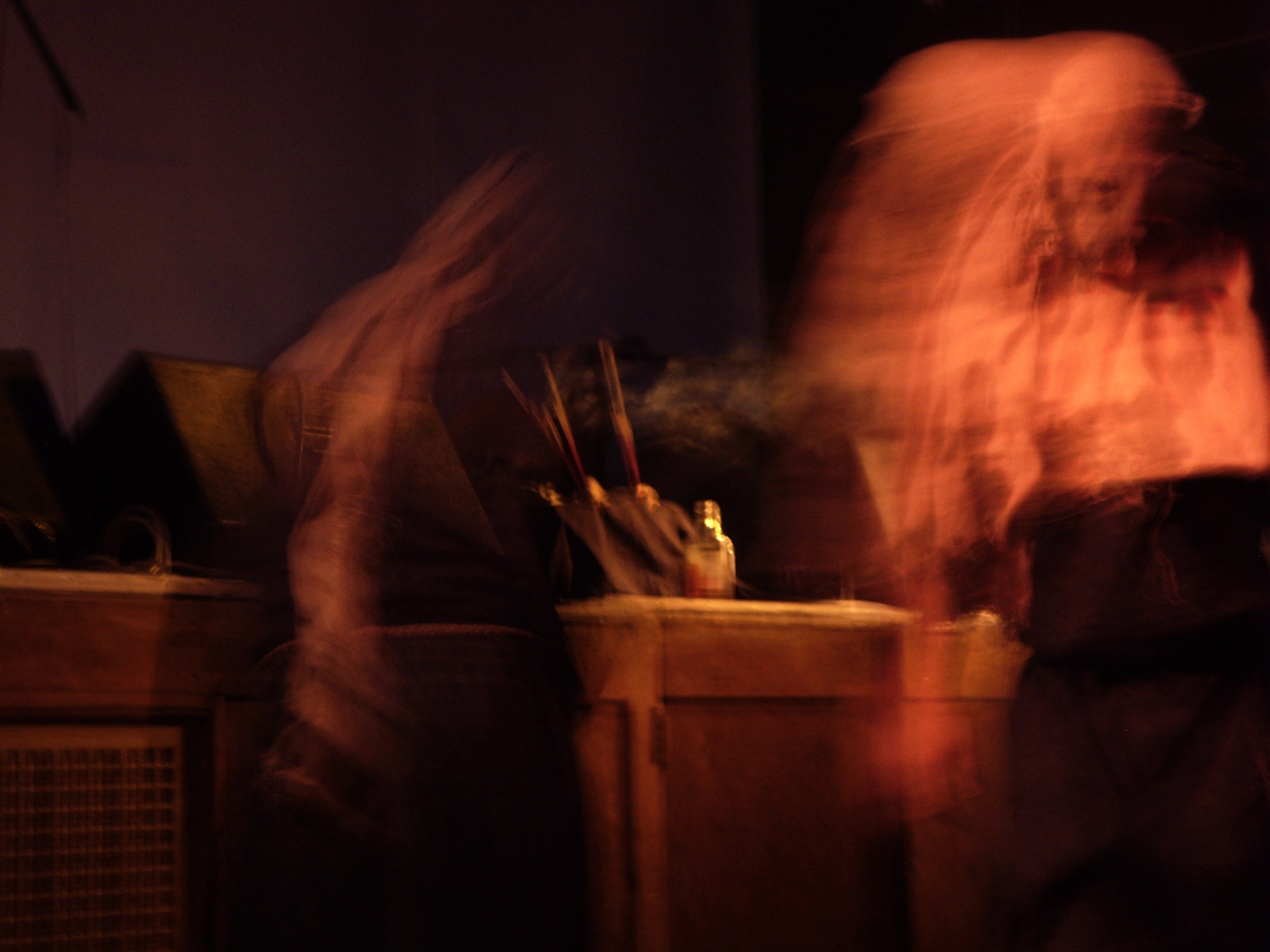
Credit: Gavin Semple
Michael: You also recently performed at Death Cult Rising III in Barcelona, along with long-time label-mates Zoät-Aon. Were there any special moments from this event you’d like to share? Was it nice to see a Zoät-Aon performance after quite a lengthy silence from them?
Arktau Eos: Death Cult Rising III was another great festival and line-up. Always reassuring to see organisers put real effort into what they do, and the sound was fantastic. Highly recommended. This urbane setting – a club resembling a scene from a David Lynch movie complete with a masonic floorboard – was a nice contrast to the rustic festivities that soon followed it in form of L’Homme Sauvage. For ourselves, it was interesting to compare how our basic set took different directions with the slightest push, transforming itself to suit the surroundings in both cases. Let us hope 2019 will turn out equally fulfilling regarding live appearances!
As for Zoät-Aon, it was and is excellent to see Jaakko Vanhala set the old beast into motion again. We have both assisted him live at one point or another (A.I.L. accompanied him for the last two shows), and he fully deserves the credit and laudation he has acclaimed throughout the years for creating his original, highly technical yet feral brand of dark ambient. A running Hypnox house in-joke calls it ‘in-your-face ambient’.
Michael: Speaking of Zoät-Aon, I wonder if there are currently any plans to release another album as Arktau Aon?
Arktau Eos: No plans exist. The whole concept would need to reworked, as we cannot possibly re-create the youthful fire and spontaneity of the original sessions. It’s a miracle they survived and were recovered from our archives in the first place!
Michael: I wonder if you would be interested in detailing any of the process of creation for Arktau Eos? I’m particularly interested in how the drones and other synthetic elements are created in association to the live elements such as percussion, chanting, etc. Do you plan these rituals out in advance, creating the synthetic elements to be utilized in the live ritual setting? Or, do you create these synthetic elements intuitively and extemporaneously during a live ritual recording process?
Arktau Eos: There is always an element of intuition involved. We are not that big on presets, and enjoy tweaking sounds live, come what may. We always ensure there is room for improvisation, the possibility of taking the set in unanticipated directions. Certainly, much is planned and rehearsed, but should the situation call for it, a trip beyond in the spirit of joyful abandon will be seized with no remorse. We will never be a sterile live act that simply attempts to recreate studio work on-stage. What we can bring along creates natural limitations and the lack of second takes guarantees certain rawness and lack of refinement, but that is not necessarily a drawback.
When crafting our sound in the studio, there is no set work-flow. The only hard-and-fast rule these days is that it should immediately evoke that unmistakable presence of otherness to which one responds at gut-level. Synthetic, organic, digital, analog – while we have our preferences (vintage when possible!), it does not matter in the end, unless we want to involve some element or a self-made instrument for a distinct reason. We are not Luddites or attempting to recreate hypothetical prehistoric music, nor hold any pretensions to that effect, so there is never a question of authenticity in that sense – playing music with only sticks, bones and stones, to fulfill someone’s idealized, absurd notion of original ritual music! Catacomb Resonator was 90% vocals, Erēmos relied on other things… and what we work on right now sits right between the two albums, subject to change as always.
The studio environment is essentially a haunted microcosm and a crucible of change.
The studio environment is essentially a haunted microcosm and a crucible of change. We treat the synthetic parts as at least half-sentient, evolving things, animated by the subtle interrelated alchemy between everything that goes on in the studio. Electricity is an organic element as much as are fire and wind. Directing control voltages through analog gear is the act of mesmerizing the machine; electromagnetism is the kuṇḍalinī of the circuits!
Therefore, we also cherish and utilize to the full the moments when old or malfunctioning synthesizers and effects decide to embark on their own trajectories, bringing about unexpected changes. This goes in tandem with our interest in the romance and mystique of ‘transmissions’, whether supernatural or shortwave! Intention, if correctly formed, eventually pulls everything together. The filaments of the spider’s web reach into the unknown, carrying resonances from afar. Some of our synths involve the operator becoming part of the actual circuits, further fulfilling a mystic conjunction of flesh and metal. Tactility is a must: you will not be seeing Arktau Eos with a laptop on-stage anytime soon, perish the thought!
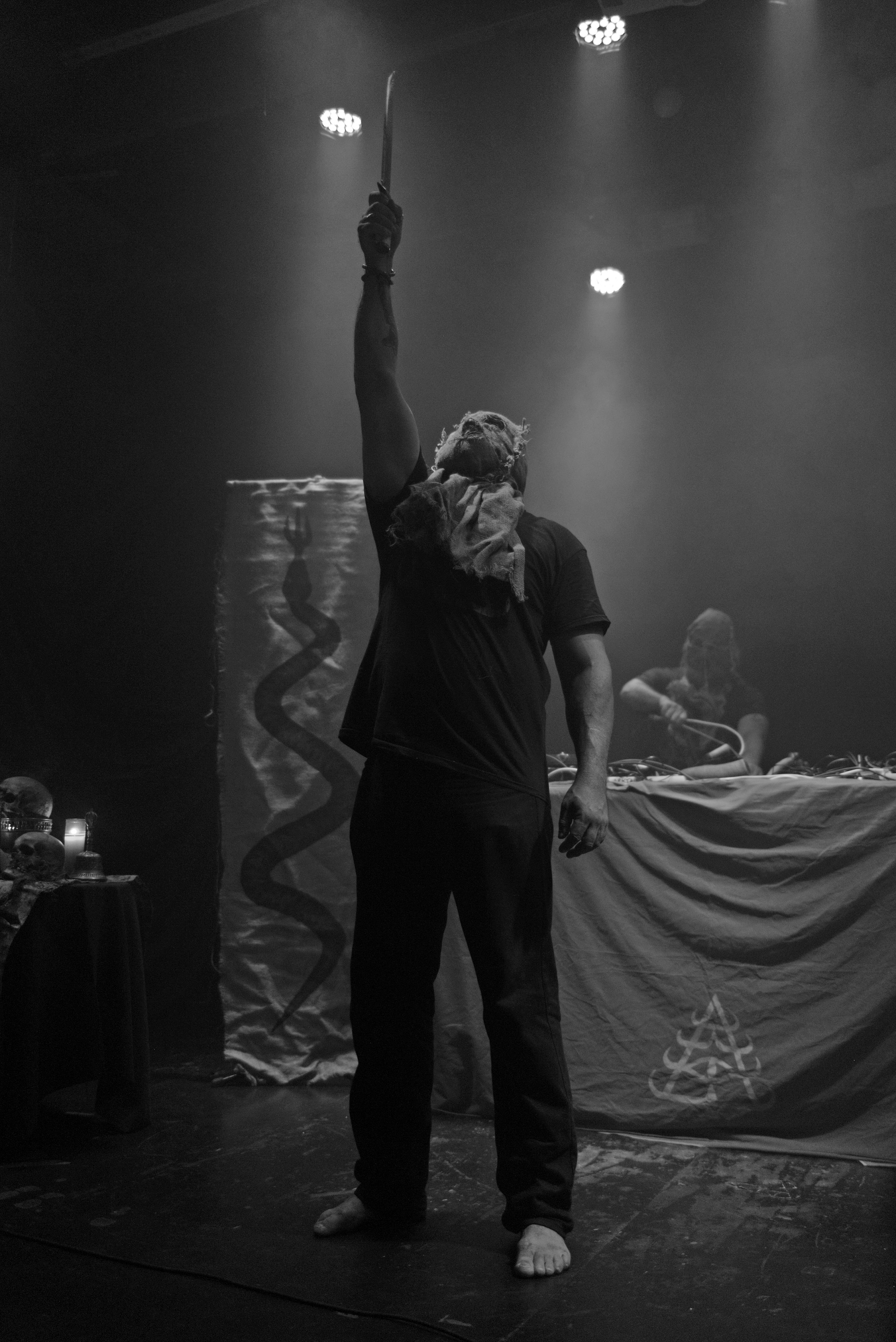
Credit: David Arranz
Michael: The ritual ambient genre seems to be growing every day. Though many of the musicians creating within this genre don’t seem to have nearly the depth of seriousness which musicians from Aural Hypnox consistently present. Would there be any certain musicians outside the Aural Hypnox/Helixes collective which you would recommend to followers of your works that are looking for the same level of dedication and authenticity?
Arktau Eos: To be honest, we do not wish to assume the mantle of arbiters regarding these matters: time will always tell. Let us see about dedication in five or ten years. Many from the old school have proven their dedication repeatedly and compared to them we are the newcomers. All hail and honour, you know who you are: acceptance by Arktau Eos is hardly needed! As for authenticity, the shallow ones are effortlessly told apart, although there is no pleasure in the exercise: those desperately striving for recognition, the pathologically self-important, the ones vacant-mindedly copying sigils from grimoires they do not grasp in hopes of impressing other dimwits, and so on, ad nauseam. All of them united by wallowing in the bitter waters of their smug self-complacency, while failing to recognize the vessel of crystal-clear stellar nectars when it is freely passed forth… You know the drill. Waste of energy, though fools may strike gold, once! More importantly, for the rest, the sincere ones we extend our well-wishes and a friendly word: just know how ‘authentic’ you want to become, because when things get real, they inevitably bring on danger, personal sacrifice – and your ego to the firing line. Those with escapist fantasies are not cut for such trials. The abyss will gaze back, unwavering.
Michael: Thank you very much for this interview, I am fully aware that these aren’t granted often, and I greatly appreciate the opportunity to speak with you gentlemen!
Arktau Eos: Thank you, it was a pleasure answering your thought-out questions! We appreciate your time and interest, wishing you the best of luck with This Is Darkness.
Arktau Eos Links
Helixes Collective Official Site
Aural Hypnox Official Site
Arktau Eos – Facebook
Aural Hypnox – Soundcloud
Aural Hypnox – Vimeo
Like this:
Like Loading...


